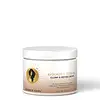What's inside
What's inside
 Key Ingredients
Key Ingredients

 Benefits
Benefits

 Concerns
Concerns

 Ingredients Side-by-side
Ingredients Side-by-side

Water
Skin ConditioningCetearyl Alcohol
EmollientPersea Gratissima Oil
Skin ConditioningCaprylic/Capric Triglyceride
MaskingAloe Barbadensis Leaf Juice
Skin ConditioningCetrimonium Chloride
AntimicrobialVp/Va Copolymer
Sorbitol
HumectantAstrocaryum Murumuru Seed Butter
EmollientArgania Spinosa Kernel Oil
EmollientButyrospermum Parkii Butter
Skin ConditioningRosa Centifolia Flower Oil
MaskingCrambe Abyssinica Seed Oil
Skin ConditioningGlycerin
HumectantHydroxyethylcellulose
Emulsion StabilisingNigella Sativa Seed Oil
EmollientTrigonella Foenum-Graecum Seed Extract
PerfumingTocopheryl Acetate
AntioxidantAdansonia Digitata Seed Oil
EmollientBehentrimonium Methosulfate
Hydroxypropyl Starch Phosphate
Phenoxyethanol
PreservativeEthylhexylglycerin
Skin ConditioningParfum
MaskingWater, Cetearyl Alcohol, Persea Gratissima Oil, Caprylic/Capric Triglyceride, Aloe Barbadensis Leaf Juice, Cetrimonium Chloride, Vp/Va Copolymer, Sorbitol, Astrocaryum Murumuru Seed Butter, Argania Spinosa Kernel Oil, Butyrospermum Parkii Butter, Rosa Centifolia Flower Oil, Crambe Abyssinica Seed Oil, Glycerin, Hydroxyethylcellulose, Nigella Sativa Seed Oil, Trigonella Foenum-Graecum Seed Extract, Tocopheryl Acetate, Adansonia Digitata Seed Oil, Behentrimonium Methosulfate, Hydroxypropyl Starch Phosphate, Phenoxyethanol, Ethylhexylglycerin, Parfum
Water
Skin ConditioningGlycerin
HumectantCaprylic/Capric Triglyceride
MaskingCetearyl Alcohol
EmollientCetyl Alcohol
EmollientGlyceryl Stearate
EmollientOryza Sativa Bran Oil
EmollientCitrus Aurantium Dulcis Peel Oil
MaskingButyrospermum Parkii Butter
Skin ConditioningGluconolactone
Skin ConditioningCalcium Gluconate
HumectantLecithin
EmollientCetrimonium Chloride
AntimicrobialTocopherol
AntioxidantPotassium Sorbate
PreservativeNelumbium Speciosum Flower Oil
Skin ConditioningPlumeria Alba Flower Extract
Skin ConditioningAvena Sativa Seed Extract
Skin ConditioningVaccinium Macrocarpon Seed Oil
Skin ConditioningChamomilla Recutita Flower Extract
MaskingEucalyptus Globulus Leaf Extract
PerfumingGinkgo Biloba Leaf Extract
Skin ConditioningAspalathus Linearis Leaf Extract
Skin ConditioningCymbopogon Schoenanthus Extract
Skin ConditioningHoney Extract
HumectantSodium Benzoate
MaskingCitric Acid
BufferingHelianthus Annuus Seed Oil
EmollientLinalool
PerfumingLimonene
PerfumingWater, Glycerin, Caprylic/Capric Triglyceride, Cetearyl Alcohol, Cetyl Alcohol, Glyceryl Stearate, Oryza Sativa Bran Oil, Citrus Aurantium Dulcis Peel Oil, Butyrospermum Parkii Butter, Gluconolactone, Calcium Gluconate, Lecithin, Cetrimonium Chloride, Tocopherol, Potassium Sorbate, Nelumbium Speciosum Flower Oil, Plumeria Alba Flower Extract, Avena Sativa Seed Extract, Vaccinium Macrocarpon Seed Oil, Chamomilla Recutita Flower Extract, Eucalyptus Globulus Leaf Extract, Ginkgo Biloba Leaf Extract, Aspalathus Linearis Leaf Extract, Cymbopogon Schoenanthus Extract, Honey Extract, Sodium Benzoate, Citric Acid, Helianthus Annuus Seed Oil, Linalool, Limonene
Ingredients Explained
These ingredients are found in both products.
Ingredients higher up in an ingredient list are typically present in a larger amount.
This ingredient is also known as shea butter. It is an effective skin hydrator and emollient.
Emollients help soothe and soften your skin. It does this by creating a protective film on your skin. This barrier helps trap moisture and keeps your skin hydrated. Emollients may be effective at treating dry or itchy skin.
Shea butter is rich in antioxidants. Antioxidants help fight free-radicals, or molecules that may harm the body. It is also full of fatty acids including stearic acid and linoleic acid. These acids help replenish the skin and keep skin moisturized.
While Shea Butter has an SPF rating of about 3-4, it is not a sunscreen replacement.
Shea butter may not be fungal acne safe. We recommend speaking with a professional if you have any concerns.
Learn more about Butyrospermum Parkii ButterThis ingredient is an emollient, solvent, and texture enhancer. It is considered a skin-softener by helping the skin prevent moisture loss.
It helps thicken a product's formula and makes it easier to spread by dissolving clumping compounds.
Caprylic Triglyceride is made by combining glycerin with coconut oil, forming a clear liquid.
While there is an assumption Caprylic Triglyceride can clog pores due to it being derived from coconut oil, there is no research supporting this.
Learn more about Caprylic/Capric TriglycerideCetearyl alcohol is a mixture of two fatty alcohols: cetyl alcohol and stearyl alcohol. It is mainly used as an emulsifier. Emulsifiers help prevent the separation of oils and products. Due to its composition, it can also be used to thicken a product or help create foam.
Cetearyl alcohol is an emollient. Emollients help soothe and hydrate the skin by trapping moisture.
Studies show Cetearyl alcohol is non-toxic and non-irritating. The FDA allows products labeled "alcohol-free" to have fatty alcohols.
This ingredient is usually derived from plant oils such as palm, vegetable, or coconut oils. There is debate on whether this ingredient will cause acne.
Due to the fatty acid base, this ingredient may not be Malassezia folliculitis safe.
Learn more about Cetearyl AlcoholThis ingredient is a preservative, antimicrobial, and emulsifier. It is often used in cosmetics for its ability to cleanse, condition, and reduce static.
Cetrimonium chloride is a quaternary ammonium salt, meaning it has a water-soluble structure.
Glycerin is already naturally found in your skin. It helps moisturize and protect your skin.
A study from 2016 found glycerin to be more effective as a humectant than AHAs and hyaluronic acid.
As a humectant, it helps the skin stay hydrated by pulling moisture to your skin. The low molecular weight of glycerin allows it to pull moisture into the deeper layers of your skin.
Hydrated skin improves your skin barrier; Your skin barrier helps protect against irritants and bacteria.
Glycerin has also been found to have antimicrobial and antiviral properties. Due to these properties, glycerin is often used in wound and burn treatments.
In cosmetics, glycerin is usually derived from plants such as soybean or palm. However, it can also be sourced from animals, such as tallow or animal fat.
This ingredient is organic, colorless, odorless, and non-toxic.
Glycerin is the name for this ingredient in American English. British English uses Glycerol/Glycerine.
Learn more about GlycerinWater. It's the most common cosmetic ingredient of all. You'll usually see it at the top of ingredient lists, meaning that it makes up the largest part of the product.
So why is it so popular? Water most often acts as a solvent - this means that it helps dissolve other ingredients into the formulation.
You'll also recognize water as that liquid we all need to stay alive. If you see this, drink a glass of water. Stay hydrated!
Learn more about Water